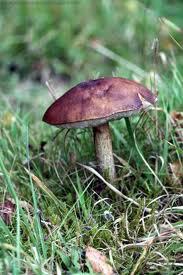With the exceptionally warm weather recently and lack of humidity, the politically correct mushroom hunting season has yet to start. It normally coincides with the opening of the hunting season in France and that started this weekend.
Once the children are back to school and the temperatures start to fall again, add a little humidity and some moonlight and you have the perfect recipe for the French favourite mushroom to spore.
The Cêpe de Bordeaux (Bolet Edulis), Edible mushroom:
So how do you find these little fellows? They prefer to lurk around at the base of oak and chestnut trees and they literally spring up overnight in the late August / September / beginning October period, following any rain showers.
They are quite difficult to spot as their cap is exactly the same colour as the leaves that have fallen around them. Once you do start finding the mushrooms, you get the second problem and that is correctly identifying them as they have very close cousins that hang about in the same kind of areas acting as decoys.
One of the many Non-Edible varieties:

A good way to learn how to tell the difference between edible and non-edible is to go mushrooming with someone who knows the difference. You will start to get the feel for the look of the mushroom.
Generally the edible cêpes have a fat bulbous stem white in colour as in the first image, whereas the non-edible variety have thinner stems which are more brownish white in colour as in the second image. The non-edible variety also bruises very easily, with the stem often discolouring fairly quickly.
The point to remember is that there are a plethora of non-edible mushrooms and you need to ensure that what you have picked is edible. The best way to do this is to take them to your local pharmacy who will confirm or otherwise the species, and whether it is edible.
When out mushrooming and with the vast tracts of forest available in France, please also remember that very often you are on someone else’s property, so respect it as you would generally respect the countryside. Second, when you are out mushrooming don't forget that it will generally be the main hunting season too and you are all playing on the same pitch - so be careful. If in doubt steer clear of any forest if there is a hunt on.
Once you have collected and identified your cêpes, there are a hundred and one things you can do with them.
To start off, you need to make sure all the creepy crawlies have left the mushroom. I have found no better method than putting the mushrooms in a clear mixing bowl and covering it with cling film. Within a couple of hours the beasties will all have come out of the mushrooms.
The French as soon as you mention cêpes cry as if in unison “Vous allez faire une bonne omelette.”
But that’s all far too boring. I prefer to caramelise some onions in the frying pan, add the coarsely chopped cepes until they start to sweat, some garlic, some parsley and add some double cream. This can be very easily be served with with a side helping of duck breast and some Sarladaise potatoes.
Cepes can be kept very easily either by cooking and conserving them in sterilised jars, but I find that by far the best method is simply to freeze them uncooked.
It's not exactly Cêpes in the City, but it can be good fun!
Happy hunting.